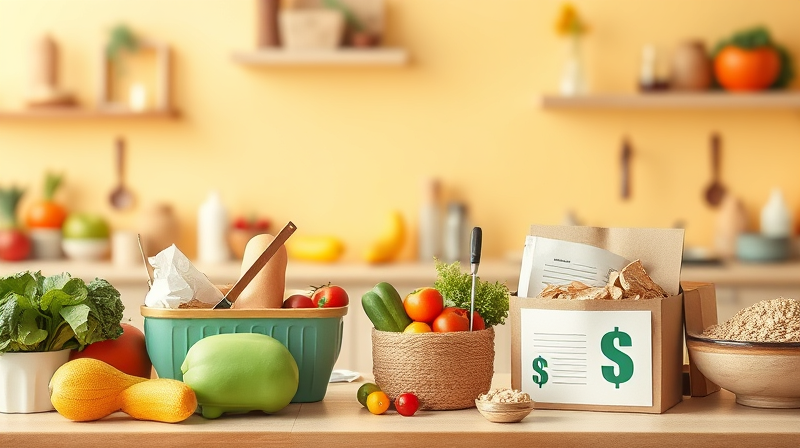When funds are limited, shopping for healthy groceries can seem like a daunting challenge. However, by approaching your grocery trips with a strategic plan and a creative mindset, you can fill your pantry with nutritious foods while still saving money. This article is designed to empower you with practical advice and insightful tips so you can achieve a balanced diet without overspending.
Every successful shopping trip begins with careful planning. A well-thought-out strategy not only helps in saving money but also minimizes waste and stress, ensuring that you have healthy meals for your family throughout the week.
Plan, Prioritize, and Prepare
Planning ahead is the cornerstone of budget-friendly grocery shopping. When you lay out your meals for the entire week, you can pinpoint exactly what ingredients are necessary. This technique helps you avoid impulse buys and reduces food waste.
- Meal Planning: Begin by listing out the meals you want to prepare and check what ingredients you already have. This practice minimizes overbuying and helps you stick to your budget.
- Create and Stick to a Grocery List: A thoughtfully prepared list based on meal planning is your best defense against unnecessary purchases. By sticking to your list, you ensure that every dollar you spend is well invested in nourishing choices.
By incorporating meal planning into your routine, you not only enjoy the benefits of a diverse and healthy diet but also enhance your skills in budgeting effectively.
This approach demonstrates that with a little forethought, it is possible to experience both fiscal responsibility and nutritional abundance.
Smart Shopping Strategies for Nutritious Foods
Knowing where and how to shop is as important as what you buy. There are several strategies that can help you make the most of your grocery dollars.
- Compare Prices: Look beyond the sticker price by checking the unit price. This enables you to spot the best deals regardless of package sizes.
- Store Layout Knowledge: Retail environments are designed to push premium products at eye level. By consciously searching higher or lower on the shelves, you can discover less expensive yet equally nutritious options.
- Generic Over Brand Names: Store brands often offer the same level of quality as their national counterparts at a fraction of the cost. Trying these alternatives can lead to significant year-round savings.
Implementing these strategies transforms each shopping trip into an opportunity to enhance your financial well-being while fostering a healthier lifestyle for you and your family.
Choosing Affordable, Nutrient-Dense Foods
Your grocery cart can be filled with versatility even on a tight budget. It is essential to focus on nutrient-dense ingredients that are both affordable and adaptable.
- Whole Grains: Items like brown rice, oats, and whole wheat pasta provide essential fiber and nutrients that play a vital role in a healthy diet.
- Proteins: Economical protein sources such as eggs, lentils, canned beans, and tuna can be the foundation for a balanced diet. These foods are not only cost-effective but also versatile enough to be included in a variety of recipes.
- Fruits and Vegetables: Prioritize seasonal produce and local markets. When prices spike, frozen or canned vegetables without extra additives can be a nutritious substitute.
- Dairy: Look for budget-friendly dairy options such as low-fat milk, plain yogurt, or block cheese which offer essential nutrients without the premium price tag.
Incorporating these items into your shopping routine ensures that each meal you prepare is balanced and rich in essential nutrients, making every bite a healthful step towards a vibrant lifestyle.
It is possible to enjoy fresh, wholesome ingredients while still keeping an eye on your budget by making informed choices.
Creative Cooking and Reducing Food Waste
Cooking at home not only promises healthier ingredients and less sodium than eating out, but it also gives you complete control over portion sizes and flavor. By preparing your meals at home, you can experiment with local and affordable ingredients, turning simple dishes into hearty, comforting meals.
Avoiding food waste requires creativity. Using leftovers in new recipes like soups, casseroles, or frittatas is a great way to maximize your ingredients and reduce waste. Freezing perishable items in manageable portions further extends their shelf life and saves every healthy morsel for later use.
This proactive approach to cooking and waste management not only protects your budget but also contributes to a more sustainable and eco-friendly lifestyle.
Leveraging Community Resources
Beyond the supermarket, numerous community resources can assist you in stretching your food dollars further. Local farmers markets, community-supported agriculture, and discount programs provide access to high-quality produce without the high price tag.
- Community Programs: Many farmers markets accept government assistance such as EBT, and some offer incentives like doubling your food dollars through various market match programs.
- Home Gardening: Even a small garden can yield a surprisingly diverse range of produce. By growing your own vegetables, herbs, or fruits, you enjoy not only the satisfaction of a homegrown harvest but also reduced dependency on store-bought goods.
Utilizing these resources can have a significant impact on your budget and nutritional intake. It’s a reminder that healthy living is a community effort and that many local programs exist to support residents in times of need.
In conclusion, buying nutritious groceries on a restricted budget is well within your reach when you plan ahead, shop smart, and embrace creative cooking techniques. Every small step, from preparing a meal plan to exploring local community resources, contributes to a healthier lifestyle and a more balanced diet. Your financial constraints do not have to translate into unhealthy eating habits. Instead, they can be the catalyst for innovation and a renewed focus on nourishing your body with quality foods.
Remember, the journey to a healthier life is built on the choices you make every day. With a little preparation and a creative spirit, you can transform your grocery shopping experience into one of empowerment, sustainability, and wholesome eating.







